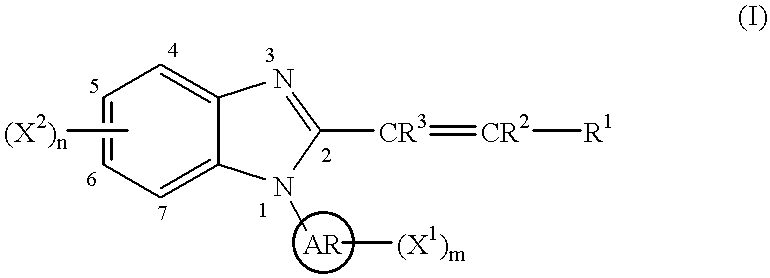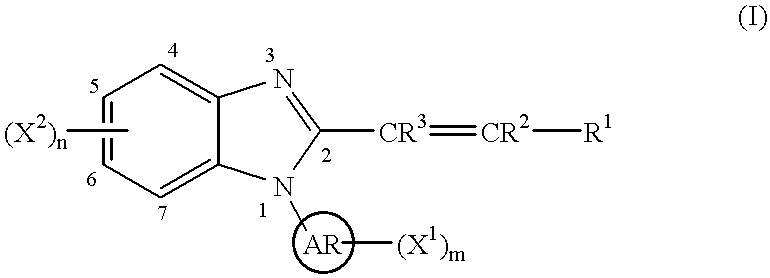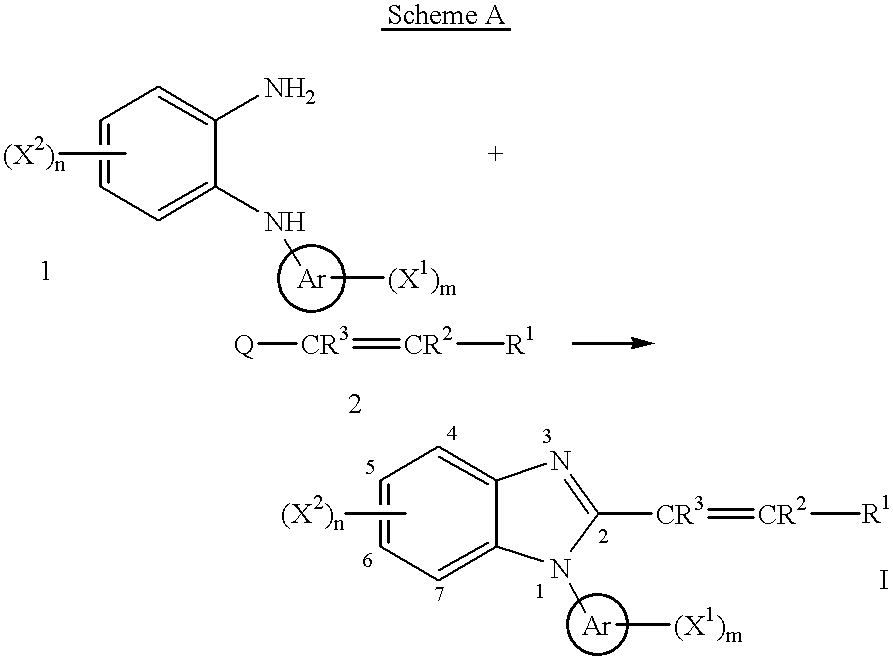Benzimidazole cyclooxygenase-2 inhibitors
a technology of benzimidazole and cyclooxygenase, which is applied in the direction of biocide, cardiovascular disorder, drug composition, etc., can solve the problems of limited therapeutic use of conventional nsaids, severe side effects,
- Summary
- Abstract
- Description
- Claims
- Application Information
AI Technical Summary
Problems solved by technology
Method used
Image
Examples
example 1
(E)-1-(2-Pyridyl)-2-styryl-1H-benzimidazole
Method A
To a stirred solution of N-(2-pyridyl)-o-phenylenediamine (0.46 g, 2.4 mmol; Stephenson, L.; Warburton, W. K. J. Chem. Soc. C, 1970, 1355) in toluene (50 ml) was added (E)-cinnamoyl chloride (0.40 g, 2.4 mmol) and the resulting mixture was heated to reflux removing water using a Dean-Stark apparatus for 13 h. After cooling, the reaction mixture was concentrated to dryness. The residue was dissolved into ethyl acetate (100 ml), washed consecutively with saturated aqueous sodium bicarbonate solution (50 ml) and brine (50 ml), dried (magnesium sulfate) and concentrated to dryness. Column chromatography (silica gel, 95 g; n-hexane / ethyl acetate (2 / 1)) followed by recrystallization from isopropyl ether yielded 0.29 g (41%) of the titled compound.
Method B
To a stirred suspension of sodium hydride (0.48 g, 12 mmol) in dimethylacetamide (20 ml) at 0.degree. C. under a nitrogen atmosphere was added a solution of (E)-2-styryl-1H-benzimidazole ...
example 2
(E)-1-(3-Pyridyl)-2-styryl-1H-benzimidazole
To a stirred suspension of N-(3-pyridyl)-o-phenylenediamine (0.93 g, 5 mmol; Kirsch, P.; Schoenleben-Janas, A.; Schirmer, R. H. Liebigs Ann. Org. Bioorg. Chem., 1995, 7, 1275) in xylene (60 ml) was added (E)-cinnamoyl chloride (0.83 g, 5 mmol). After stirring at the room temperature for 1 h, the resulting mixture was heated to reflux removing water using a Dean-Stark apparatus for 11 h. After cooling, the reaction mixture was concentrated to dryness. The residue was dissolved into ethyl acetate (100 ml), washed consecutively with saturated aqueous sodium bicarbonate solution (50 ml) and brine (50 ml), dried (magnesium sulfate) and concentrated to dryness. The residue was purified by column chromatography (silica gel, 165 g; n-hexane / ethyl acetate (3 / 2 to 1 / 1)) to give 0.77 g (34%) of brown solids. Recrystallization from isopropyl ether yielded 0.50 g of the titled compound as pink solids.
MW: 297.36; mp: 118.0-118.5.degree. C.; .sup.1 H-NMR ...
example 3
(E)-1-(4-Pyridyl)-2-styryl-1H-benzimidazole
A solution of N-(4-pyridyl)-o-phenylenediamine dihydrochloride (2.6 g, 10 mmol) in ethyl acetate (100 ml) was washed consecutively with a 0.5 N aqueous solution of sodium hydroxide (100 ml), water (100 ml) and brine (100 ml), dried (sodium sulfate) and concentrated in vacuo to give the free base as yellow solids. To a stirred solution of N-(4-pyridyl)-o-phenylenediamine obtained above in pyridine (50 ml) was added (E)-cinnamoyl chloride (1.7 g, 10 mmol) and the mixture was heated under reflux for 3 h. Then the volatiles were removed under reduced pressure and the residue was dissolved in chloroform (100 ml). The organic phase was washed consecutively with saturated aqueous sodium bicarbonate solution (50 ml) and brine (50 ml), dried (sodium sulfate) and concentrated in vacuo. The residue was purified by column chromatography (silica gel, 100 g; n-hexane / ethyl acetate (1 / 1)) and then recrystallized from ethyl acetate to afford 131 mg (4%) of...
PUM
| Property | Measurement | Unit |
|---|---|---|
| temperature | aaaaa | aaaaa |
| temperature | aaaaa | aaaaa |
| temperature | aaaaa | aaaaa |
Abstract
Description
Claims
Application Information
 Login to View More
Login to View More - R&D
- Intellectual Property
- Life Sciences
- Materials
- Tech Scout
- Unparalleled Data Quality
- Higher Quality Content
- 60% Fewer Hallucinations
Browse by: Latest US Patents, China's latest patents, Technical Efficacy Thesaurus, Application Domain, Technology Topic, Popular Technical Reports.
© 2025 PatSnap. All rights reserved.Legal|Privacy policy|Modern Slavery Act Transparency Statement|Sitemap|About US| Contact US: help@patsnap.com



